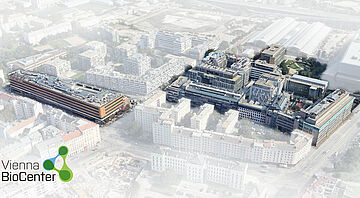MECHANISMS OF CHROMOSOME SEGREGATION

The precise orchestration of chromosome segregation during cell division is an essential mechanism for all life. Research at the Vienna BioCenter has contributed greatly to illuminating the sophisticated mechanisms underlying both normal and aberrant chromosome segregation, with far-reaching implications for tackling cancer and infertility.
Accurate chromosome segregation is crucial for the proliferation of somatic cells and the production of haploid gametes during meiotic divisions. Mistakes during this process give rise to aneuploidy, which is a characteristic of most malignant tumor cells and is the leading cause of spontaneous fetal abortion. Kim Nasmyth dominated the field during his time at the IMP with a rapid series of incisive and high impact discoveries, predominantly in the 1990s. His group exploited Saccharomyces cerevisiae as their model system due to the unparalleled power of its genetics as well as the highly conserved nature of cell division.
One of their first major breakthroughs was the discovery of the anaphase-promoting complex (APC), which they found was required to degrade cyclins and subsequently for chromosome segregation (Irniger et al., Cell 1995; Zachariae et al., Science 1996). Shortly after, the Nasmyth group identified three chromosomal proteins, which we now know to be part of the cohesin complex, required to hold sister chromatids together during metaphase before their separation in anaphase (Michaelis et al., Cell 1997). They subsequently discovered that the APC destroys securin to release separase, a protease that specifically cleaves the Scc1 subunit of cohesin to allow sister chromatid separation (Ciosk et al., Cell 1998; Uhlmann et al., Nature 1999; Uhlmann et al., Cell 2000). Finally, and perhaps most significantly, the Nasmyth group showed that the stable association between cohesin and chromatin is topological rather than physical, with the cohesin complex forming a ring around the sister chromatids (Gruber et al., Cell 2003; Ivanov and Nasmyth, Cell 2005).
This remarkable progress over a relatively short period of time provided the molecular answer to the fundamental question of what holds sister DNA molecules together until their segregation in mitosis or meiosis. The innovative ‘ring hypothesis’ also had a substantial impact on other fields. For example, it implied that similar protein complexes might also act by entrapping DNA within ring structures. Indeed, this has been shown for condensin complexes, which mediate chromosome condensation, and SMC complexes, which segregate bacterial genomes. Ultimately, the entrapment of DNA by cohesin-related complexes may have been essential for the very evolution of DNA genomes and their segregation mechanisms.
Nasmyth’s work on chromosome segregation – largely performed during his time at the Vienna BioCenter – was awarded the 2018 Breakthrough Prize in Life Sciences, which recognizes transformative advances towards understanding living systems and extending human life. It triggered a cascade of scientific discoveries that continues even today. This cascade is being further propelled by scientists at the Vienna BioCenter, who continue to investigate the complex and fascinating process of chromosome segregation, including how cohesion is established and maintained, how it is released, and how errors leading to chromosome missegregation result in disease.
Publications:
Irniger S, Piatti S, Michaelis C, Nasmyth K. Genes involved in sister chromatid separation are needed for B-type cyclin proteolysis in budding yeast. Cell 1995; 81:269–78.
Zachariae W, Shin TH, Galova M, Obermaier B, Nasmyth K. Identification of subunits of the anaphase-promoting complex of Saccharomyces cerevisiae. Science 1996; 274:1201–4.
Michaelis C, Ciosk R, Nasmyth K. Cohesins: chromosomal proteins that prevent premature separation of sister chromatids. Cell 1997; 91:35–45.
Ciosk R, Zachariae W, Michaelis C, Shevchenko A, Mann M, Nasmyth K. An ESP1/PDS1 complex regulates loss of sister chromatid cohesion at the metaphase to anaphase transition in yeast. Cell 1998; 93:1067–76.
Uhlmann F, Lottspeich F, Nasmyth K. Sister-chromatid separation at anaphase onset is promoted by cleavage of the cohesin subunit Scc1. Nature 1999; 400:37–42.
Uhlmann F, Wernic D, Poupart MA, Koonin EV, Nasmyth K. Cleavage of cohesin by the CD clan protease separin triggers anaphase in yeast. Cell 2000; 103:375–86.
Gruber S, Haering CH, Nasmyth K. Chromosomal cohesin forms a ring. Cell 2003; 112:765–77.
Ivanov D, Nasmyth K. A topological interaction between cohesin rings and a circular minichromosome. Cell 2005; 122:849–60.



